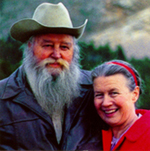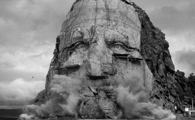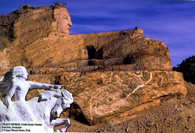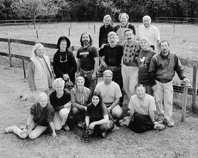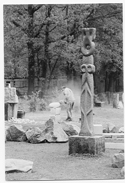Psychoanalysis and Stone Carving - Sept/Oct 2003
- Details
- Created: Monday, 01 September 2003 22:18
“The great virtue of stone is that unlike other hard materials it seems to have a luminous life, light, or soul.”- Adrian Stokes, Stones of Rimini, 1934
July 2003. Psychoanalysis has always been interested in the creativity and the arts, but recently the Northwest Alliance for Psychoanalytic Study, one of the organizations in Seattle’s lively and creative psychoanalytic community, has embarked on a more intensive exploration of the interconnections between psychoanalysis and the arts. We are interested not in psychoanalyzing the artist or explaining away the meaning of a work of art, but rather in the creative process itself as it works both in psychotherapy or psychoanalysis and in the arts, and in the way the arts can foster a rich and meaningful engagement with emotion-laden issues.
As a new stone carver with a lifelong interest in the psychology of the creative process, I have been eager to reflect on stone carving from this point of view. Talking to my psychotherapist and psychoanalyst colleagues, I find not only that some of them are already carvers themselves but also that many others have long harbored a fantasy of learning to carve someday. And so the Northwest Alliance for Psychoanalytic Study will be sponsoring an introductory workshop on stone carving (hand tools and soft stone) for its members in January 2004, where we can talk about the connections between psychotherapy and stone carving on the basis of direct experience.
The following essay was written to contribute to this dialogue with my psychoanalytic colleagues. I think it will be of interest to stone carvers as well. It is an attempt to reflect on the analogies between carving and the psychoanalytic process, and on the inner meanings of the activity of carving. It draws on the work of Adrian Stokes (1902-1961), an English painter, poet and writer on the arts, a writer who is deeply knowledgeable about both the arts and psychoanalysis.
Blind Native American sculptor Michael Naranjo was given permission by the Pope to touch, indeed climb on, Michelangelo’s gigantic marble statue of Moses. A documentary film shows him exploring the curves of Moses’ body and face with his hands, and on a later journey running his fingertips over the nose and around the eyes of Michelangelo’s statue of David and resting them on David’s lips as though listening. The marble has taken on the living quality of flesh, he says.
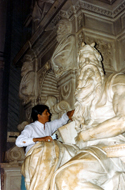
All of us who have run our hands over stones have, I think, an intuition of how stone can feel organic, like flesh. This is part of the reason so many of us harbor a secret fantasy of working in stone. Adrian Stokes’ conception of carving articulates the way stone can become like a living body.
Stokes grew up in England and as a young man traveled across the Alps to Italy. What he saw in Italy was an evenly lit landscape of luminous limestone architecture. (Limestone is rock sedimented from the sea; marble is a form of limestone.) The contrast between this vision of Italy and the gloom of England was Stokes’ fundamental aesthetic intuition. He elaborated this intuition in a series of books on art and architecture, including The Quattro Cento and Stones of Rimini. In the 1930s he was in psychoanalysis with Melanie Klein for a number of years and afterwards used an implicit psychoanalytic framework to articulate his aesthetic ideas. Although not a clinician himself, Stokes was a member of the Imago group in London, a group of analysts and non-analysts who met to use psychoanalytic ideas to illuminate non-clinical dimensions of life.
Stokes made the distinction between carving and modeling a key theme in his writings on the arts. His distinction is simple. Carving cuts away; modeling builds up. Of course art uses both processes, but Stokes is particularly interested in exploring the meaning of carving. Carving, he says, involves enlivening the medium one is using, whereas in modeling the medium is no more than “suitable stuff”: “A figure carved in stone is fine carving when one feels that not the figure, but the stone through the medium of the figure, has come to life.”
Stone is the preeminent material for carving. Not even primarily for its durability, says Stokes, but rather for its translucent (rather than reflective) quality: “I am thinking of the equal diffusion of light that, compared to most objects, even the hardest and darkest stones possess; I am thinking of hand-polished marble’s glow that can only be compared to the light on flesh-and-blood.” This inherent luminescence is for Stokes one symbol of life.
Carving as Stokes conceives it is essentially an interaction both psychic and sensory between sculptor and stone. The stone is the mother’s body that the baby explores and the lover caresses; the stone is the matrix of mind into which the psyche projects: “The sculptor is led to woo the marble. Into the solidity of stone, a solidity yet capable of suffused light, the fantasies of bodily vigor, or energy in every form, can be projected, set out and made permanent.” The interaction is ongoing; if the fantasies enliven the stone, the stone’s evolving form elicits a further elaboration of the fantasies.
From the imaginative point of view, the motion of carving is not so much a cutting as a rubbing, a stroking: “It will readily be understood that in the carving of stone’s hard, luminous substance, it suffers all the stroking and polishing, all the definition that our hands and mouths bestow on those we love.” Michael Naranjo’s fingers exploring the face of Michelangelo’s David evokes the infant’s exploration of the mother’s face. If mobility is another indicator of aliveness, then the motions of the sculptor’s, or the baby’s, or the lover’s hand, help to endow the stone, the mother’s face, the body caressed, with aliveness.
For Stokes, the primordial Mediterranean art is stone architecture; the stone provides a house, a shelter, a container. Stone for the sculptor, says Stokes, is a matrix. “Just as the cultivator works the surfaces of the mother earth so the sculptor rubs his stone to elicit the shapes which his eye has sown in the matrix.” He asserts that the matrix must remain implicitly present in the sculpted form: “The carved form should never, in any profound imaginative sense, be entirely freed from its matrix” because “carving is an articulation of something that already exists in the block.”
How does the metaphor of “sowing,” which, psychologically considered, is an image of projection, accord with the idea that carving regards and enlivens the inherent nature of its medium? Here we are in the realm of images for generativity. At the end of Aeschylus’ Oresteia the goddess Athene argues that the child is not related to the mother because she is merely the field in which the seed has been sown! The metaphor of sowing in a field is perhaps not the best one to articulate the inherent resonance of what is implicit in the matrix and what is projected by the wooer.
A more suggestive image, to my mind, is that of unfurling, similar to the development of an embryo and eventual birth from the womb. Stokes notes that softer stones like marble tend to be carved away to greater thinness than harder stones and such figures suggest the unfurling of something that has been folded up inside the matrix:
“Their curves . . . will be more capable of a varied palpitation in their defining of forms. Such definition of form by whittling and polishing marble, so that in representational art the figures themselves tend to be flattened or compressed, as if they had long been furled amid the interior layers of the stone and now were unburdened on the air, were smoothing the air, such thinness of shape appears to me to be the essential manner of much stone carving.”
What is so fascinating to me in this image is the notion of something coming to light - its own light - and into the air, bearing the form of a collaborative process whereby both stone and hand play the role of mind. I recently visited the Musée
Rodin in Paris, where many of the sculptures are visibly sheltered by the marble matrix from which they have emerged. But the carving that struck me most was one done late in Rodin’s life, a sculpture of two hands emerging from the stone matrix. The title of this piece is “The Secret.”
All quotations are from the excerpts from Stones of Rimini in The Image in Form: Selected Writings of Adrian Stokes, edited by Richard Wollheim (New York: Harper & Row, 1972), pp. 150-4.
The video, “Michael Naranjo: A New Vision” shown on KNME, Albuquerque, NM, in l996, can be ordered from New Mexico PBS by calling: (800) 328-5663.
Shierry Nicholsen is a new stone carver, taking classes with Sabah Al-Daher at the Pratt Fine Arts Center in Seattle. She was inspired by Inuit carving and by the work of her old friend Karl Hufbauer. She enrolled in Sabah’s class after a dream in which her college boy friend, who became a geologist, presented her with a set of carving tools for her birthday. Shierry is a psychoanalytic psychotherapist in private practice in Seattle and the author of The Love of Nature and the End of the World: The Unspoken Dimensions of Environmental Concern (MIT Press, 2002).

